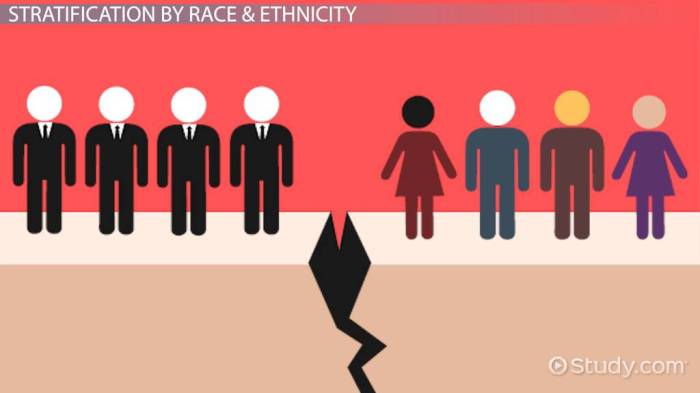Racial stratification is almost extinct thanks to reform attempts – Racial stratification, a historical scourge, has been significantly diminished thanks to sustained reform efforts. This article examines the concept of racial stratification, its historical roots, and the impact of reform attempts in mitigating its pervasive effects. It concludes by identifying remaining challenges and proposing future directions for addressing residual stratification.
Racial Stratification: Historical Context
Racial stratification refers to the hierarchical organization of society based on race, with certain groups systematically advantaged or disadvantaged compared to others. Historically, racial stratification has been justified through ideologies such as scientific racism and social Darwinism, which falsely posited the superiority of certain races over others.Legal
and social factors have played a significant role in perpetuating racial stratification. Laws like the Jim Crow system in the United States enforced racial segregation and discrimination, while social norms and practices reinforced these divisions. As a result, racial stratification became deeply ingrained in societies, shaping access to resources, opportunities, and social status.
Reform Attempts: An Overview

Efforts to address racial stratification have a long history, with varying degrees of success. These reform attempts have included:
- Civil rights legislation:Laws like the Civil Rights Act of 1964 and the Voting Rights Act of 1965 outlawed discrimination based on race, providing legal protections for marginalized groups.
- Affirmative action policies:Programs designed to promote equal opportunities for underrepresented groups in areas such as education and employment.
- Community development initiatives:Investments in underserved communities to improve housing, education, and economic opportunities.
While these reform attempts have made progress in dismantling legal barriers and increasing opportunities for marginalized groups, they have also faced challenges and limitations.
Contemporary Perspectives on Racial Stratification: Racial Stratification Is Almost Extinct Thanks To Reform Attempts

Despite reform efforts, racial stratification persists in contemporary society, albeit in more subtle and complex forms. Research shows that racial disparities exist in areas such as:
- Education:Students from marginalized racial groups often have lower access to quality education and resources.
- Housing:Racial segregation and discrimination in housing markets limit opportunities for upward mobility.
- Criminal justice:Racial bias in policing, sentencing, and incarceration disproportionately affects communities of color.
Understanding the contemporary manifestations of racial stratification is crucial for developing effective policies to address its root causes.
Future Directions: Addressing Residual Stratification

To effectively address residual racial stratification, future reform efforts must focus on:
- Addressing systemic racism:Recognizing and dismantling the institutional barriers that perpetuate racial disparities.
- Promoting economic equality:Investing in policies that create economic opportunities for marginalized groups.
- Enhancing educational opportunities:Ensuring equitable access to quality education for all students, regardless of race.
- Reforming the criminal justice system:Eliminating racial bias in policing, sentencing, and incarceration.
By implementing comprehensive and sustained reform efforts, we can strive to create a more just and equitable society where racial stratification is truly eradicated.
Popular Questions
Is racial stratification still a significant issue in contemporary society?
While reform attempts have made progress, racial stratification persists in various forms, particularly in areas such as education, housing, and criminal justice.
What are the key factors that have contributed to the decline of racial stratification?
Legal reforms, such as the Civil Rights Act of 1964, and social movements have played a crucial role in challenging discriminatory practices and promoting equal opportunities.
What are the remaining challenges in addressing racial stratification?
Residual stratification exists in subtle forms, such as implicit bias, unequal access to resources, and systemic barriers. Ongoing efforts are needed to address these challenges.